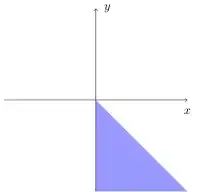I would like to resolve this exercise: Let $W$ be a Brownian motion with $T_1=1 \text{ year}$ and $T_2=2 \text{ years}$.
I want to compute the probability that $W_{T_1}$ be positive and $W_{T_2}$ negative.
What I did:
$X=W_{T_1}$ and $ Y=W_{T_2}-W_{T_1} $ independent $\sim$ Gaussian So our probability is: $$P(X>0,X+Y<0)=\int_0^{+\infty} \int_{-\infty}^{-x} \frac{1}{2 \pi} e^{- \frac{1}{2} (x^2+y^2)} \, dx \, dy $$
But I don't know how to continue.
Thanks for your help
